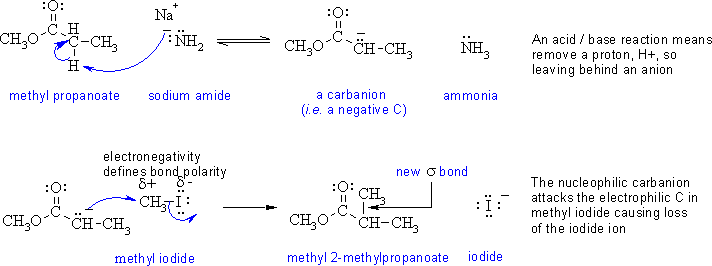
The following diagram shows the solution
to the mechanistic question.
Note that all the information applies to a single reaction
sequence
that has been completely described verbally. There is no
need
for extra reagents or extra
steps etc. The curly arrows are
drawn
specifically to match the text in the question. The biggest problem
students
have is making sure they understand the language of chemistry. Most
students
have trouble because they can't draw the structures from the IUPAC
names (that means they don't know their nomenclature well enough).
Read the words carefully, and then make the curly arrows tell
that
same story. There is NO need for extra steps. Remember curly arrows
go from electron rich
to poor and to balance the formal charges at each step -
errors on formal charges were common.
Common
stumbling blocks for
some
students were :
(a)

If you struggled with this part of the question, first draw the compounds whose names were provided, then think about the types of reactions (e.g. acid / base) and try to fill in the structures in the gaps, then finally add the required curly arrows to account for all the bonding changes.
In this problem, if you didn't know what
sodium amide was, then
you should have been able to work it out from the knowing what
ammonia
was and that amide forms ammonia after an acid - base reaction (i.e.
simple proton transfer) and given that it tells you that amide
is a base in the question....
If you were not sure which H+ to remove,
then there are 2 clues (a) only one set give a carbanion that is
resonance stabilised and (b) by looking at the location of the new
methyl group in the product.
(b)
(i) The significant resonance
structures can
be drawn by delocalising the charge on the C to
the
O atom by using the -ve lone pair to form a new C=C and breaking the
C=O. The two major
contributors are the most significant. Note the question asked for the
carbanion.

(ii) Acidity : The methyl propanoate is more acidic than propane as indicated by the lower pKa (25 versus 50+ respectively). The major factor is the resonance stabilisation of the conjugate base of the ester (as shown above) where the negative charge on C can be delocalised to the more favourable (i.e. more stable) location on the electronegative O atom. Propane, only has a simple, unstabilised carbanion.
(iii)
If you wanted to prepare methyl
2-methylhexanoate
from methyl propanoate using this type of reaction, you
should react the carbanion of the propanoate with 1-iodobutane (aka
butyl iodide) = CH3CH2CH2CH2I
instead of the methyl iodide (as stated in the question the ester
undergoes alkylation when
reacted with a base and then an alkylating agent)
that was used in the first part of
the
question (count C atoms... in the question 4 + 1 gives 5.... need 8
have 4.... use C4 alkylating agent). A simple comparision of the
overall reaction in part (a) reveals the answer:
